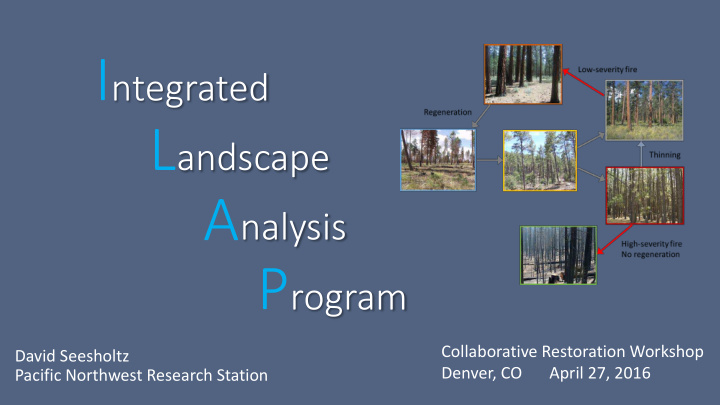



I ntegrated L andscape A nalysis P rogram Collaborative Restoration Workshop David Seesholtz Denver, CO April 27, 2016 Pacific Northwest Research Station
State and Transition Models: STM (StSim: http://www.apexrms.com/projects/stsm) Growth & succession Fire and Growth & salvage 1 in succession 200 chance Halofsky, J. E., M. K. Creutzburg, et al., Eds. (2014). Integrating social, economic, and ecological values across large landscapes . PNW-GTR-896. Portland, OR, USDA Forest Service, PNW Research Planting or natural regeneration Station.
ILAP Development
Development Multiple Partners Knowledge Discovery Knowledge Delivery ILAP
ILAP can help inform restoration prioritization
Blue Mountains Area Reference Conditions Blue Mountains modeling area: 24.6 million acres National Forest Lands: about 6.7 million acres across 4 national forests Lower Joseph modeling area: about 453,000 acres National Forest Land in Lower Joseph (HUC 5 watershed): about 103,000 acres
Blues Potential Vegetation Types
Blues Current Forest Vegetation Structure
Blues Reference Conditions Forest Structure
Moving Toward Reference Setting 1 – Increase the dominance of western larch (with lodgepole) and ponderosa pine. Increase patch sizes for large and giant sized trees. Shoot for at least 20% of area in LG size classes with at least half of that in closed conditions. At least half area of LG forests should be in large patches. About 20% of the area should be in grass/forb/shrub and seedling/sapling conditions. DRAFT – Subject to change
Moving Toward Reference Setting 2 – Increase the dominance of ponderosa pine. Large patches (well over 100 acres) of LG should dominate, forming more than 30% of the area. LG patches should be highly connected. Open patches (mostly < 20 acres) of grass/forb/shrub and seedlings/saplings should occupy 8-10% of potentially forested area. DRAFT – Subject to change
Potential Changes in Large Trees per Acre over 30 Years for the Lower Joseph Project No Management Modified PA PA-High
Key ILAP Contacts • Jimmy Kagan - ILAP Lead Jimmy.kagan@oregonstate.edu 503-725-9955 • Miles Hemstrom - ILAP Science Leader ILAP Website – www.oregonstate.edu/inr/ilap Miles.hemstrom@oregonstate.edu The Western Landscapes Explorer 503-730-5479 (www.westernlandscapesexplorer.info) provides public access to ILAP data, models and tools, as well as other landscape-level information. • David Seesholtz dseesholtz@fs.fed.us PNW-GTR-896. Portland, OR, USDA Forest Service, 208-373-4179 PNW Research Station. http://www.fs.fed.us/pnw/pubs/pnw_gtr896.pdf
Recommend
More recommend